
Zero Wing is a 1989 side-scrolling shooter arcade video game developed by Toaplan and originally published in Japan by Namco and in North America by Williams Electronics. Controlling the ZIG space fighter craft, players assume the role of protagonist Trent in a last-ditch effort to overthrow the alien cyborg CATS. It was the eighth shoot 'em up game from Toaplan, and their fourteenth video game overall.

Sonic Drift is a 1994 racing game based on Sonic the Hedgehog developed and published by Sega for the Game Gear. Players control one of four characters as they race to the finish line, with 18 tracks themed after levels in 1991's Sonic the Hedgehog.
Power Strike is a series of vertically scrolling shooter video games, developed by Compile for the Master System and Game Gear. It consists of three titles, only one of which was designed from the ground up as a Power Strike title. The other two are Aleste games re-branded for release outside of Japan.
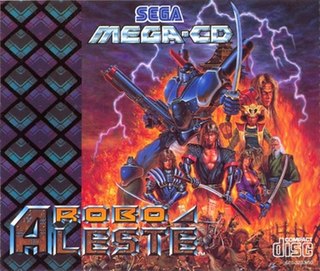
Robo Aleste, released in Japan as Dennin Aleste (電忍アレスタ), is a 1992 vertically scrolling shooter video game developed and published by Compile for the Sega CD. Tengen and Sega released the English version of the game overseas in 1993. It is a follow-up to MUSHA for the Sega Genesis. A sequel titled Dennin Aleste 2 was planned for the Sega CD on 1993, but was cancelled.

Jungle Strike is a video game developed and published by Electronic Arts in 1993 for the Sega Genesis. The game was later released on several other consoles such as the Super Nintendo Entertainment System (SNES), and an upgraded version was made for DOS computers. The Amiga conversion was the responsibility of Ocean Software while the SNES and PC DOS versions were that of Gremlin Interactive, and the portable console versions were of Black Pearl Software. It is the direct sequel to Desert Strike and is the second installment in the Strike series. The game is a helicopter-based shoot 'em up, mixing action and strategy. The plot concerns two villains intent on destroying Washington, D.C. The player must use the helicopter and occasionally other vehicles to thwart their plans.
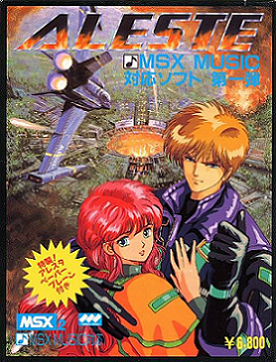
Aleste (アレスタ) is a vertically scrolling shooter developed by Compile, originally published by Sega in 1988 for the Master System and then by CP Communications for the MSX2. The Master System version was released outside Japan as Power Strike. The game spawned the Aleste and Power Strike franchises.

Soulstar is a hybrid rail shooter/third-person shooter video game developed and published by Core Design for the Sega CD in North America in September 1994, Europe in October by Core Design, and in Japan by Victor Entertainment on December 22.

is an arcade-style Formula One racing video game developed and manufactured by Sega for the Genesis/Mega Drive, Master System, and the Game Gear in 1992. It is a follow-up to Super Monaco GP. The game was also endorsed by, and had technical input from, the then-Formula One champion Ayrton Senna. Gameplay includes a World Championship season featuring recreations of the tracks in the 1991 Formula One World Championship, along with a three-race "Senna GP" mode set on fictional tracks.

MUSHA is a vertically scrolling shooter developed by Compile and released for the Sega Genesis in 1990. An entry in Compile's shooter series, Aleste, MUSHA places the player in the role of a flying mecha pilot who must destroy a large super intelligent computer threatening planet Earth. The game had a working title of Aleste 2 and originally featured a style similar to the first game, but this was changed to a more original Japanese aesthetic and speed metal soundtrack.

Aleste 2 (アレスタ2) is a scrolling shooter video game developed and released by Compile for the MSX2 in 1989 exclusively in Japan. It is a sequel to Aleste and is the first game in the Aleste series to feature the recurring series heroine Ellinor who later appeared in Musha Aleste. Aleste 2, along with other Compile shooters, was also released for the now-defunct WOOMB service. In 2009, ProjectEGG released the game digitally for Windows, also in English.
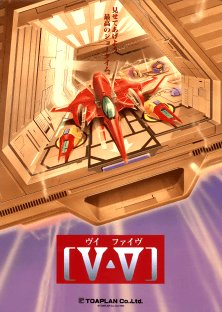
Grind Stormer is a 1993 vertically scrolling shooter arcade video game originally developed and published by Toaplan in Japan and North America. It is considered to be the spiritual successor to Slap Fight. Based around a video game within a video game concept, players assume the role of a young secret agent assigned by the government taking control of the NA-00 space fighter craft in an attempt to defeat the titular virtual reality simulator, rescue the abducted players who lost against it and unveil its true purpose.

Galaga '91 is a 1991 fixed shooter video game developed and published by Namco for the Game Gear. It was published by Sega in Europe and renamed Galaga 2. The first portable installment in the Galaxian series, players control a lone starfighter in its mission to eradicate the hostile Galaga forces before they take over Earth. Gameplay revolves around shooting down formations of enemies and avoiding their projectiles.
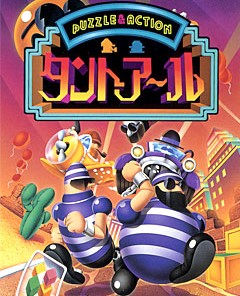
Puzzle & Action: Tant-R, is a puzzle video game developed and published by Sega in 1993 for the Sega System C in Japan. The first instalment in the Puzzle & Action trilogy, it is a spin-off of Bonanza Bros.. The characters from Bonanza Bros., Robo and Mobo, are featured as protagonists, functioning as detectives. A prison escapee is chased, and his henchmen interfere. A series of timed mini-games must be completed to defeat the henchmen. The game features references to western culture.

Night Striker is a 1989 shoot 'em up video game developed and published by Taito for the Taito Z System. In the game, the player flies an armoured car shooting enemy invaders to destroy a terrorist organisation. Night Striker combines gameplay elements of Sega's Space Harrier and Out Run. Versions were released for the Sega Mega-CD in 1993, Sony PlayStation in 1995, and Sega Saturn in 1996. A version was released on the Taito Memories II Gekan compilation for the PlayStation 2 in 2007. Night Striker received mixed reviews, and the Mega-CD version in particular was heavily criticized, primarily due to poor graphics. The music was composed by Taito's Zuntata sound team, and has been released separately.

Seirei Senshi Spriggan is a 1991 vertically scrolling shooter video game developed by Compile and published by Naxat Soft in Japan for the PC Engine CD-ROM². In the game, the player assume control of Jega and Rikart piloting the Spriggan in order to protect their country from the Buraizubara empire.

Power Strike II is a 1993 vertically scrolling shooter video game developed by Compile and published by Sega. Part of the Aleste series, the game takes place across the seas and skies near Italy during the 1930s, with the player assuming the role of a Pothunter piloting the Falcon Flyer aircraft to shoot down sky pirates, former pilots that turned to air piracy for survival as result of the Great Depression in 1929. It retains the same gameplay conventions as the original Power Strike, with the player fighting endless waves of enemies while avoiding collision with their projectiles and other obstacles.
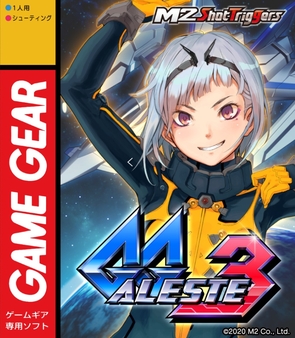
GG Aleste 3 is a 2020 vertically scrolling shooter video game developed and published by M2. It was included as part of the Aleste Collection for Nintendo Switch and PlayStation 4, as well as in a Game Gear Micro variant bundled as part of a limited edition. An entry in the Aleste series, the game follows Luna Waizen, a pilot candidate scrambled into service after destruction of the Moon Child base and fight against cyber terrorists that have seized control of the Earth's satellites. It retains the same gameplay conventions as the original GG Aleste and GG Aleste 2, with the player fighting endless waves of enemies while avoiding collision with their projectiles and other obstacles.

GG Aleste is a 1991 vertically scrolling shooter video game developed and published by Compile for the Game Gear. An entry in the Aleste series, the game follows Ellinor Waizen piloting the Galvanic Gunner space fighter craft to face against the invading Moon Child army. Its gameplay follows the same conventions as earlier Aleste titles, with the player fighting waves of enemies and bosses, while avoiding collision with their projectiles and other obstacles.
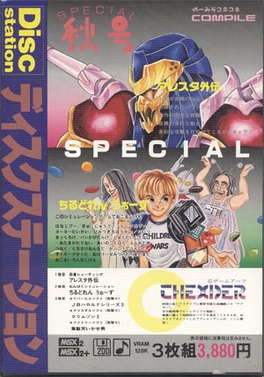
Aleste Gaiden is a 1989 vertically scrolling shooter video game developed and published by Compile for the MSX2 home computer. A follow-up to Aleste (1988), it was included as part of the autumn special edition of Disc Station, a monthly disk publication by Compile. It is a sidestory to the main series, taking place in an alternative continuity. Controlling the soldier Raymond Waizen, protagonist of the first game wearing a cybernetic ninja suit, the player must overthrow the supercomputer DIA 51 by fight waves of enemies and bosses, while avoiding collision with their projectiles and other obstacles.

Undeadline is a 1989 vertically scrolling shooter video game developed and originally published by T&E Soft for the MSX2 and MSX2+ home computers. It was later ported to the X68000 computer and Sega Mega Drive, published by Palsoft, followed by digital re-releases for Microsoft Windows. Both the MSX2 and X68000 versions also received physical re-releases by Japanese retailer BEEP. It follows a group of characters in rescue of queen Althea from Zidane, a kingdom surrounded by barriers connected with the demon world, whose monsters have overflowed it. Controlling either a fighter, wizard, or ninja, the player can choose from six stages and play them in any order, fighting against waves of enemies and bosses, while defending or avoiding collision with their projectiles and other obstacles.




















